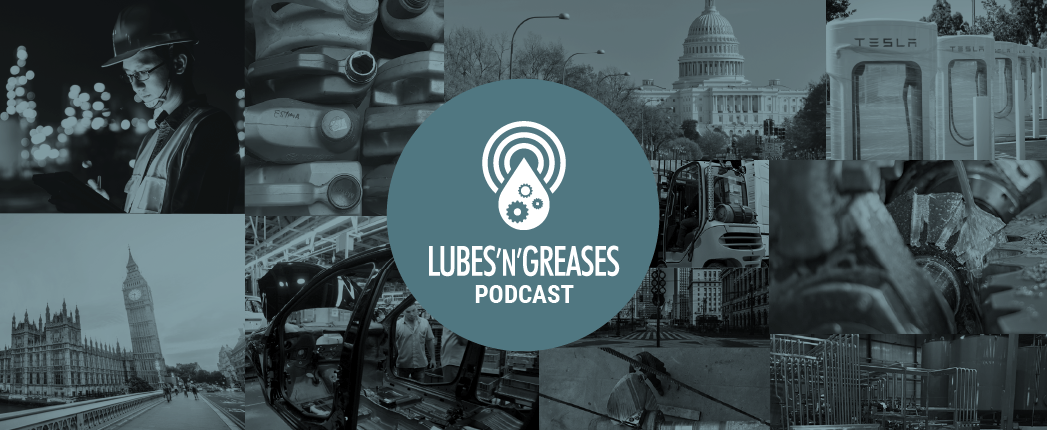
The sky isn’t about to fall in on the automotive lubricants sector. Far from it, thinks Adam Banks, Afton Chemical’s senior marketing manager of e-mobility. PCMO still has a way to go, and depending on the market and the mode of transport, the eventual rate of volumetric decline will be slower than some observers of the industry had feared.
Two-wheelers, especially in India and China, are going electric faster than four wheeler and on-road heavy duty faster than off-road, he says.
Adam reminds us of the core role lubrication plays in keeping things moving and that there will be more mobility – not less – in the future. He also shares a startling fact about the contribution ICEs can make to decarbonizing transport.
This podcast discusses topics covered in an article in November’s Lubes’n’Greases magazine.


SJ: Hello and welcome back to the LNG podcast with me Simon Johns. I’m delighted to welcome our guest Adam Banks, senior marketing manager of e-mobility at Afton Chemical. Hello Adam.
AB: Hi Simon
SJ: The November edition of Lubes’n’Greases will feature an article based on your presentation at the ICIS world Base Oils conference in Windsor, back in May-June. To my mind, the presentation was essentially about the future of the automotive lubricants business and where the potential opportunities are, even as vehicles that don’t use a traditional PCMO keep growing and growing in number. In places like Norway, they are the only cars almost being sold off the lot. But I think your presentation, it changed the way I thought quite substantially, which is why it kind of really stuck in my mind, and I thought I should reach out to you.
Because two years ago, I would have said that the sky is falling in for the automotive lubricants sector. And since every quarter there was record breaking EV registration numbers, especially in Europe and China. So my first question to you, Adam, is you talked in your presentation about opportunities and risks. So, can you paint a more realistic picture than mine? Sure.
AB: I think it’s a common roller coaster of emotion or perception that you’ve been through there. I don’t think you’re in any way unusual with that. It does seem like a scary change in any big kind of change like that will be. You know, at the highest level, we’re talking about changing our complete energy system, which potentially is as big a change as the Industrial Revolution. So, it’s significant, of course.
But there’s a lot of things that go into it. And when you net all of that out, it is much slower in terms of a change that impacts the lubricants industry, and lots of other factors are in there.
So, if we look at the combustion engine, yes, an electric vehicle will use less lubricant over the course of his life than a vehicle with a combustion engine. True. But at the core of it, what the lubricant industry does is we’re keeping things moving. And regardless of anything else, we’ll need more motion, not less of it in the future. So, there’s going to be a demand for lubricants. And so will still be needed. It depends on the sector, and how quickly the change.
I think there are two factors that greatly slowed the change. One is the lag in terms of fleet. So even in Norway – where as you mentioned the sales of EVs and hybrids are almost total – there’s still a demand there in terms of the fleet that remains. And that’s just passenger cars, in the commercial vehicles that will be much slower. So that’s on a, you know, the same kind of trajectory, but coming much later. And then the second factor is the growth in vehicle numbers globally. So you put those two things together – the lag on the fleet and the growth in vehicle numbers – and it means that the sky is not about to falling on our heads in the projections for 2040 that we’ve got, I think I referenced it in the talk was it’s effectively steady demand at 2040 for passenger car, let alone the other sectors that we see. So, I think there’s cause for optimism there.
SJ: Yeah, definitely. That’s a really great message for the industry. And you mentioned slow change over time, between now and 2014 was when your projections go to. What are these slow changes likely to be?
AB: I think it’ll depend where you are and which sector you’re talking about, that those timings vary greatly with each of those. So in Europe, and if you’re particularly focused on passenger car, or even more, so maybe two wheelers, those are things which could electrify relatively quickly. And so of course, you’ll feel that pace of change much more so.
We’re all aware, of course of the EU regulations about moving to full electrification, and so that the sales of new combustion engines at that point will cease. However, if you look at things like heavy commercial vehicle, and particularly if you’re outside of Europe, or California, things will take a lot longer to change – the infrastructure, the energy, as well as simply the capital to invest in those kinds of machinery is not there to move it even if there was a big drive to do so.
And so, I think there’s something else that the lubricants industry can do to help with decarbonization, and that is helping improve the efficiency of things. There’s one IEA projection that I saw which suggested that by 2030, on a trajectory towards net zero, that cleaning up carbon-emitting vehicles would have a greater impact then changing over to new technology. And so, lubricants can have a lot of effect on that.
SJ: What order of magnitude they’re talking about in terms of, you know, the difference between cleaning up internal combustion engines and switching over to e-mobility?
AB: Yeah, so for that stat for 2030, I think it was a bit over half of the contribution would be from a clean up as opposed to a new technology.
SJ: That’s amazing. And I assume by clean up you mean gradual development of ICEs, rather than sort of literally introducing technologies into existing vehicles.
AB: So that clean up is around, can we make better versions of those things that exist today? Can we have cleaner burning combustion engines? And I think there is also about, can we make those that exist already run better?
SJ: Where and how will innovation happen? If the industry is a bit nervous about risking the investment in new formulas and additives?
AB: Maybe the emphasis may change in terms of where it’s placed? If we look at that question of decarbonization, again, or – and with that, where the lubricants industry will last longest, because those two things are connected – we will see more opportunity for longer in heavy duty than we will in two-wheeler, for example. And so, I think there’s a more obvious or less risky strategy in terms of investing in the heavy-duty area, as opposed to in two-wheeler, and some could say passenger car although some might say on a sliding scale. However, I think there will still need to be new technology for all of those areas, I would be quite happy if our competition stopped competing in those areas.
And we can say that. I don’t see that dropping off a cliff dramatically today.
SJ: Another question you sort of preempted slightly was, I know you can’t comment specifically about any one of your competitors. But I was just wondering, as one of the big four as it were you of course pay attention to what your competitors are up to. Would you say that there’s general consensus about the trends that will affect your businesses? Or do you think reading the runes, do you all have a different approach?
AB: I mean, I can only say what we see in the public domain, from our competition, of course, but broadly, the views seem to be similar. Indeed, I seem to remember an article which was in the esteemed publication LNG, which Oronite put out, I think, and they had a projection out to 2060. If I remember, with passenger car, motor oil being flat out til then. Now, I thought it was a bold move to predict 40 years in the future, nearly, you know, if you go back to 1983, and try and predict what the world will be like today, you’d struggle I think.
However, I mean, we’ve got to make predictions and forecasts. So fair enough, but it mirrored our projections for 2040. And so, on the basis of that, yes, what they’re stating in the public domain looks very similar.
I mean, that those competitors are somewhat in different positions. So I think Afton Chemical, we’re in a good position being diversified within lubricants. We serve most sectors. Lubrizol is further diversified into other sectors like health care and personal care and so on. And indeed, they even go into finished lubricants, which we wouldn’t do. So, their e-coolants division, for example.
But what I can say as well is that the competition within factory fill for electric vehicles is intense. So, you know, by that measure, I can see our competition working very hard at that. And so yes, I think broadly speaking, what we see and what they see must be similar.
SJ: That really raises the question about what new applications or growth areas there are going to be, come the inevitable day when, however far in the future, when PCMO becomes no longer viable. Where is Afton seeing the opportunities?
AB: I think, we will continue to innovate in those areas we spoken about because, you know, it will be phased as to when different things go become electrified.
As I mentioned, two-wheeler might be the one that is easiest to electrify. So you know, for Southeast Asia, for India, and so on, you could see that converting quicker. We already see evidence of that in China, passenger cars later.
But there’s new fluids required for that in terms of the transmission oils. And that’s been a lot of my work and a lot of what we’ve been competing with competition on for the last number of years.
I think heavy duty will come next. And that’s on road heavy duty off road. We’ll come back even later than that. And then industry and manufacturing will remain largely unchanged by this.
So that in a sort of order of when the impact is going to hit, that explains a few things. And with that, then there’s going to be growth in each of those. So big growth in demand for trucks and moving things around the world. And so, that requires investment that in those areas, then we’ll see e-coolant being an interesting area of opportunity. I think that’s something that’s new. I think it’s more interesting in some ways for our customers than it is for us as an additive company. A lot of it’s driven by the base oil effect. And so, the treat rate is relatively smaller. But if you look at publicly what some of our customers are doing, the oil market is there’s a lot of focus on equivalents.
SJ: In fact, a large part of your presentation was about transmission fluids for electric vehicles, what are you looking at as the main sort of obstacles and challenges to kind of get products to market and the, you know, the kind of growth in that sector?
AB: Yeah, I mean, the products to market requires a customer. And largely, it’s still a fight in factory fill, first fill for OEMs. So, there’s a technology fight there, as opposed to trying to convince consumers to take it, for example, that’s just the phase that we’re in.
So, it’s much more around the technological challenge. And so that’s around applying lubricant directly to electrified systems, which brings in new requirements and new challenges, as well as the way that the power is laid down and other things.
So, working with the OEMs, to figure out their challenges to provide the right balance, as is also the case with these lubricants, to meet those technological needs.
In terms of sort of the specific needs, that that engenders, then, you know, we’re putting things on electrified systems, you then need to consider the electrical properties of the fluid, which we didn’t really think about with the transmission fluid before. There are the thermal properties, which become important both in new and aged fluids. And then this compatibility with lots of new materials, so in electric motor, copper, the polymers and coatings and so on, while still maintaining the other functions of the lubricant by protecting the gears, and so on.
SJ: What technological solutions are kind of vying for dominance? Is there a race for dominance amongst the technologies? Or there’s lots of space at the table for different fluids, different formulas to coexist, depending on OEM specifications?
AB: Yeah, I think so. And even more so than everything gets written around a specification eventually. But at the moment, the hardware designs are diverging more than converging. And so, we see that as a result of that, it’s much more about customizing it for the individual OEM.
So rather than speaking about dominance, or anything like that, it’s still about trying to continually improve the technology options that we’ve got. And it’s not one size fits all, it’s trying to find the right thing for the OEM and for our customer. To do that.
SJ: There was a nice graphic that you used with a Dachia Sondero on one side and a Tesla Model S on the on the righthand side. So you know, running through the different kind of fluid quantities. What’s the what’s the best-case scenario for Afton?
AB: The slide you’re referring to is looking at the fluid volumes associated with each type of vehicle. And was trying to paint a picture of where we’ll see more or less used.
There are two factors, of course, with any kind of lubricant system. One is how big is the sump, or how much lubricant does that component take? And how often will it be changed.
So, looking at the different transmission options that exist, there are some which create more volume opportunity for the industry than others.
The Dachia Sandero being a manual transmission in most of its sales, is a liter and a half/two liters, something like that, and not usually drained unless there’s a service requirement – repair requirements rather. So that’s relatively modest in terms of its per vehicle demand.
In the middle, we’ve got things like automatic transmissions that we’ve had for a long time, the Fill volume there is larger, and depending on the type, it may require a drain over the course of his life. So improve things substantially.
When we look at electric vehicles, there’s a couple of significantly different architectures. So we refer to them as wet and dry systems. So that means whether we are directly lubricating the electric motor or not, in that price system, which is a lot of the electric vehicles on the road today, the lubricant is only on the gearbox, it doesn’t lubricate the electric motor.
But there’s a lot of efficiency to be gained for the manufacturer in direct lubrication of the electric motor, which is of interest for them and the consumers. And so that’s definitely the direction of travel; that will improve things. So then it’s a larger some volume and perhaps with a drain interval.
So, when we compare those broadly, we see that that the volume requirements in a dry EV is similar to a manual transmission, whereas in a wet EV is more similar to an automatic transmission over time we’re seeing for those vehicles with combustion engines, more manuals moving towards automatics and we’re seeing More of the EBS moving from dry to wet. So overall, that’s a good thing. If you would like some more volume, which we would like, of course.
SJ: Of course, just a final question, then. I’m going to backtrack slightly to a comment you made earlier about changing sort of timelines, depending on the marketplace. And I thought I’d ask you a home question.
After Rishi Sunak, our prime minister, announced pushing back the ICE ban by five years. I just want to know what your take was whether from a business perspective, that’s a good thing or from a personal perspective, that’s not necessarily a good thing.
AB: I think it’s a lot of politicking, isn’t it? About the headline message and everything else? And interesting that I think the OEMs reaction has been somewhat muted. And the deeper explanation for that, I think, is that aside from the headline figure for 2030, or 2035, there’s a requirement for OEMs from next year to sell a significant portion of their vehicles as electrified, and that is a much bigger driver for them. And that remains unchanged.
But you could also question whether the rules may change with a different government before we get there. Who knows? But I think it’s more about high politics and anything else, I don’t think is that consequential.